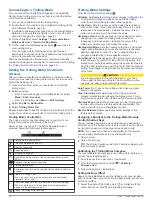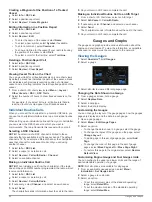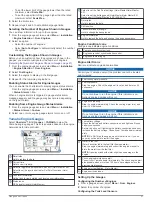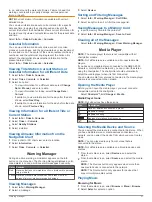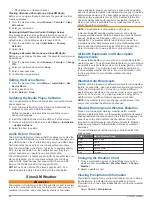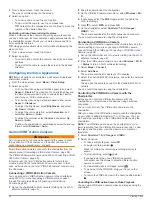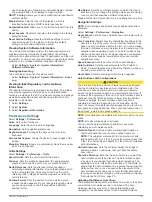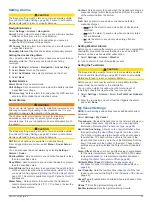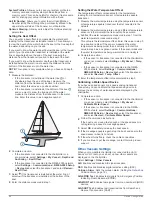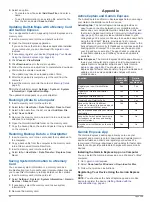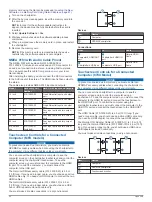
Alternating Among Multiple Video Sources
If you have two or more video sources, you can alternate
between them using a specific time interval.
1
From the video screen, select
Menu
>
Source
>
Alternate
.
2
Select
Time
, and select the amount of time each video
appears.
3
Select
Source
, and select the video sources to add to the
alternating sequence.
Networked Video Devices
NOTICE
A Garmin Power over Ethernet (PoE) Isolation Coupler (P/N
010-10580-10) must be used when connecting Ethernet
devices, such as FLIR
®
cameras, to a Garmin Marine Network.
Connecting an Ethernet device directly to a Garmin Marine
Network chartplotter damages the Garmin chartplotter and may
damage the Ethernet device.
Before you can view and control video devices such as IP
cameras, encoders, and thermal cameras using your
chartplotter, you must have a compatible video device
connected to your chartplotter, and you must have a marine
network cable Power over Ethernet (PoE) isolation coupler. Go
for a list of compatible devices or to purchase a
PoE Isolation Coupler.
You can connect multiple supported video cameras and up to
two video encoders to the Garmin Marine Network. You can
select and view up to four video sources at once. Chartplotters
with multiple composite built-in video inputs can display a single
built-in video input only. When the cameras are connected, the
network detects them automatically and displays them in the
source list.
Using Video Presets on Networked Video Cameras
You can save, name, and activate video presets for each
networked video source.
Saving Video Presets on a Networked Video Camera
1
From a video screen, touch the screen.
The video controls appear on the screen.
2
Hold a video preset button.
A green light indicates the setting is stored.
Naming Video Presets on a Networked Video Camera
1
From a video screen, select
Menu
>
Video Setup
>
Presets
.
2
Select a preset.
3
Select
Rename
.
4
Enter preset name.
Activating Video Presets on a Networked Video Camera
You can quickly return networked cameras to preset values.
1
From a video screen, touch the screen.
The video controls appear on the screen.
2
Select a video preset.
The camera restores the video settings saved for that preset.
TIP:
You can also save and activate presets using the video
menu.
Camera Settings
Some cameras provide additional options to control the camera
view.
NOTE:
Not all options are available on all camera models and
chartplotter models. Refer to the camera manual for a list of
available features. You may need to update the camera
software to use this feature.
From the infrared video screen, select Menu.
IR Blend
: Selects the infrared effect to MSX
®
(Multi-Spectral
Dynamic Imaging) mode or CTV (Color Thermal Vision
™
)
mode, and allows you to blend the effects.
IR/Visible
: Displays an infrared or visible light image.
Scan
: Surveys the surrounding area.
Freeze
: Pauses the camera image.
Change Colors
: Selects the color scheme of the infrared image.
Change Scene
: Selects the infrared image mode, such as day,
night, MOB, or docking.
Video Setup
: Opens more video options.
Video Settings
Some cameras provide additional setup options.
NOTE:
Not all options are available on all camera models and
chartplotter models. You may need to update the camera
software to use this feature.
From the video screen, select
Menu
>
Video Setup
.
Set Input
: Associates the camera with a video source.
Mirror
: Reverses the image like a rearview mirror.
Standby
: Places the camera in standby mode to conserve
power and protect the lens when not in use.
Home Position
: Sets the home position of the camera.
Scan Speed
: Sets how quickly the camera moves during a
scan.
Scan Width
: Sets the width of the image captured by the
camera during a scan.
Stabilization
: Stabilizes the picture using mechanical means.
Low Light
: Optimizes the video for low-light environments.
Aspect
: Sets the aspect ratio.
Defog
: Optimizes the video for foggy environments.
Dynamic Range
: Sets the range to wide or standard.
E. Stabilization
: Stabilizes the picture using software image
processing.
Light
: Controls the camera's integrated light source to help
illuminate the environment.
Name
: Allows you to enter a new name for this camera.
FLIR™ Menu
: Provides access to the settings for the camera.
Associating the Camera to a Video Source
You may need to associate the camera with a video source.
1
From the video screen, select
Menu
>
Source
.
2
Select the camera.
3
Select
Video Setup
>
Set Input
.
4
Select the video input.
Video Camera Movement Control
NOTICE
Do not aim the camera at the sun or extremely bright objects.
Damage to the lens may occur.
Always use the chartplotter controls or buttons to pan and tilt the
camera. Do not manually move the camera unit. Manually
moving the camera may damage the camera.
NOTE:
This feature is available only when a compatible camera
is connected. You may need to update the camera software to
use this feature.
You can control the movements of the connected video cameras
that support panning, tilting, and zooming.
Controlling Video Cameras Using On-Screen Controls
On-screen controls allow you to control pan-tilt-zoom (PTZ)
cameras. Refer to the camera manual for a list of available
features.
Viewing Video
57


